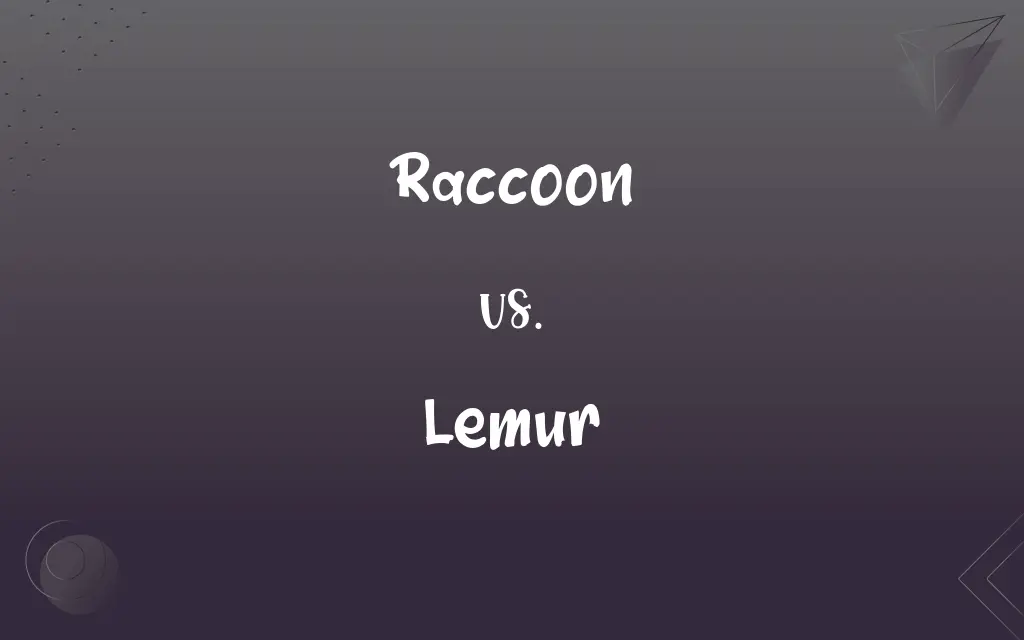Raccoon vs. Lemur: What's the Difference?
Edited by Aimie Carlson || By Janet White || Updated on March 3, 2024
Raccoons are North American mammals known for their dexterous front paws and masked facial markings, thriving in diverse habitats. Lemurs are primates unique to Madagascar, with large eyes and a long tail, primarily arboreal and active at night or dusk.

Key Differences
Raccoons, belonging to the Procyonidae family, are medium-sized mammals native to North America. They are easily recognizable by their distinctive black "mask" of fur around their eyes and their bushy, ringed tails. Raccoons are known for their remarkable adaptability, able to thrive in forests, mountains, and even urban areas. Lemurs, on the other hand, are a group of primates found exclusively on the island of Madagascar and some small surrounding islands. They are known for their large, reflective eyes adapted to their nocturnal or crepuscular (active at dusk and dawn) lifestyles.
The diet of raccoons is omnivorous and highly varied, including fruits, nuts, insects, and small animals, demonstrating their adaptability to different environments. They are also known for their intelligence and problem-solving abilities, often remembered for washing their food before eating, although this behavior is believed to be more about tactile sensation due to the sensitivity of their paws. Lemurs, in contrast, have diets that can vary significantly among species but generally consist of fruit, leaves, and occasionally insects and small vertebrates. Their social structures and behaviors are diverse, with some species living in large matriarchal societies, while others are more solitary or live in small family groups.
Raccoons and lemurs also differ significantly in their conservation status. Many raccoon populations are stable and even expanding, particularly in urban areas where they have adapted to living in close proximity to humans. Lemurs, however, are among the most endangered groups of animals in the world, primarily due to habitat destruction and fragmentation in Madagascar. Conservation efforts for lemurs are critical, focusing on habitat preservation and reforestation to ensure their survival.
Raccoons and lemurs may share some superficial similarities, such as their notable eyes and agility, they are quite different in terms of taxonomy, behavior, diet, and conservation status. Raccoons are adaptable omnivores that have thrived in various environments, while lemurs are specialized primates facing significant conservation challenges.
Comparison Chart
Taxonomy
Mammal, Procyonidae family
Primate, unique to Madagascar
ADVERTISEMENT
Habitat
North America, diverse environments
Madagascar, primarily arboreal habitats
Physical Traits
"Masked" face, bushy ringed tail
Large eyes, long bushy tail
Behavior
Omnivorous, adaptable, solitary or small groups
Primarily herbivorous, nocturnal/crepuscular, social in varied group sizes
Conservation
Stable or increasing populations
Many species endangered, habitat conservation critical
Raccoon and Lemur Definitions
Raccoon
Their front paws are highly sensitive and capable, used for grasping and manipulation.
The raccoon skillfully opened the latch with its dexterous front paws.
ADVERTISEMENT
Lemur
Lemurs mainly eat fruit, leaves, and occasionally insects.
The lemur reached for the ripest fruits hanging from the tree branch.
Raccoon
They are usually solitary but may come together in small, loose family groups.
A small group of raccoons gathered by the riverside at dusk.
Lemur
Many lemur species are endangered due to habitat loss.
Conservationists are working hard to protect lemur habitats from deforestation.
Raccoon
Raccoons have a varied diet that includes fruits, insects, and small animals.
The raccoon rummaged through the garden, feasting on both vegetables and insects.
Lemur
Adapted for their nocturnal or crepuscular lifestyle.
The lemur's large eyes glinted in the moonlight, scanning the forest.
Raccoon
They thrive in forests, urban areas, and suburbs.
Raccoons have adapted well to city life, often seen rummaging through trash cans.
Lemur
They are unique to Madagascar and its surrounding islands.
Lemurs are a symbol of Madagascar's unique biodiversity.
Raccoon
An omnivorous mammal (Procyon lotor) native to the Americas and introduced elsewhere, having grayish-brown fur, black masklike facial markings, and a black-ringed bushy tail.
Lemur
Lemur societies range from solitary to matriarchal groups.
The ring-tailed lemurs formed a tight-knit group, led by a dominant female.
Raccoon
The fur of this mammal.
Lemur
Any of various primates of the infraorder Lemuriformes of Madagascar and adjacent islands, having elongated lower incisors and nails on all digits except the second toe of the hind foot.
Raccoon
Any of various similar or related animals.
Lemur
(colloquial) Any strepsirrhine primate of the infraorder Lemuriformes, superfamily Lemuroidea, native only to Madagascar and some surrounding islands.
Raccoon
An omnivorous, nocturnal mammal native to North America, typically with a mixture of gray, brown, and black fur, a mask-like marking around the eyes and a striped tail; Procyon lotor.
Lemur
Any of the genus Lemur, represented by the ring-tailed lemur (Lemur catta).
Raccoon
Any mammal of the genus Procyon.
Lemur
(obsolete) A loris (Lemur tardigradus, now Loris tardigradus), predating the 10th edition of Systema Naturæ.
Raccoon
Any mammal of the subfamily Procyoninae, a procyonine.
Lemur
One of a family (Lemuridæ) of nocturnal mammals allied to the monkeys, but of small size, and having a sharp and foxlike muzzle, and large eyes. They feed upon birds, insects, and fruit, and are mostly natives of Madagascar and the neighboring islands, one genus (Galago) occurring in Africa. The slow lemur or kukang of the East Indies is Nycticebus tardigradus. See Galago, Indris, and Colugo.
Raccoon
Any mammal of the family Procyonidae, a procyonid.
Lemur
Large-eyed arboreal prosimian having foxy faces and long furry tails
Raccoon
Any mammal superficially resembling a raccoon, such as a raccoon dog.
Raccoon
A North American nocturnal carnivore (Procyon lotor) allied to the bears, but much smaller, and having a long, full tail, banded with black and gray. Its body is gray, varied with black and white. Called also coon, and mapach.
Raccoon
The fur of the North American racoon
Raccoon
An omnivorous nocturnal mammal native to North America and Central America
Raccoon
Raccoons are primarily active at night.
At night, the raccoon's masked face is often glimpsed by the light of a streetlamp.
FAQs
How do raccoons' dexterous paws benefit them?
Their sensitive, capable paws allow raccoons to manipulate objects, open containers, and access food, aiding their survival in various environments.
What role do lemurs play in Madagascar's ecosystem?
Lemurs are crucial for seed dispersal due to their fruit-heavy diets, supporting the health and regeneration of Madagascar's forests.
What makes raccoons adaptable to urban environments?
Raccoons' intelligence, dexterity, and omnivorous diet allow them to thrive in urban settings by exploiting human waste and structures.
Are all raccoons nocturnal?
While primarily nocturnal, urban raccoons may also be active during the day due to the availability of food and reduced human activity.
How do raccoons adapt their diet in urban environments?
In urban areas, raccoons adapt by consuming readily available food sources such as garbage, pet food, and garden produce, showcasing their omnivorous and opportunistic feeding habits.
Do raccoons have natural predators?
Raccoons face predation from larger mammals like coyotes and bobcats, and in urban areas, they are also at risk from domestic dogs and vehicle collisions.
What challenges do raccoons face in urban areas?
Despite their adaptability, urban raccoons face challenges like vehicle traffic, potential for disease transmission, and conflict with humans.
How does deforestation in Madagascar affect lemur populations?
Deforestation leads to habitat loss and fragmentation, threatening lemur survival by reducing their living space, food sources, and breeding opportunities, and increasing their vulnerability to predators.
Why are lemurs endemic to Madagascar?
Lemurs evolved in isolation on Madagascar after the island separated from mainland Africa, leading to a diverse range of species found nowhere else.
How do lemurs communicate within their groups?
Lemurs use a variety of vocalizations, scents, and body language to communicate with group members, especially in dense forest environments.
Why are lemurs among the most endangered primates?
Lemurs are endangered primarily due to habitat destruction, hunting, and the illegal pet trade, exacerbated by Madagascar's political and economic challenges.
Can lemurs be found outside of Madagascar?
While lemurs are endemic to Madagascar, some species have been introduced to small neighboring islands, and others live in captivity around the world.
Can raccoons be kept as pets?
While some people keep raccoons as pets, they are wild animals with specific needs and behaviors that make them unsuitable for most domestic settings.
What conservation efforts are in place for lemurs?
Conservation efforts for lemurs include habitat preservation, reforestation, ecotourism, and education programs to protect these unique primates and their habitats.
What conservation strategies are being employed to protect lemurs?
Strategies include protected area management, local community engagement in conservation, captive breeding programs, and international collaboration for habitat restoration.
What distinguishes lemurs from other primates?
Lemurs are distinguished by their unique evolutionary history, isolated habitat in Madagascar, diverse range of species, and adaptations like nocturnal lifestyles and long, bushy tails.
What is the social structure of raccoon families?
Raccoon social structures can vary, but they often form loose, matriarchal family units, especially during the breeding season when females raise their kits.
What impact do raccoons have on local ecosystems?
Raccoons can impact local ecosystems by preying on bird eggs and amphibians, competing with native species for food, and potentially spreading diseases.
What are the main threats to lemur conservation?
The main threats include habitat destruction due to slash-and-burn agriculture, illegal logging, mining, and hunting, along with climate change impacts.
How do raccoons communicate with each other?
Raccoons communicate through a variety of vocalizations, including growls, whistles, and screams, as well as through scent marking and physical gestures.
About Author
Written by
Janet WhiteJanet White has been an esteemed writer and blogger for Difference Wiki. Holding a Master's degree in Science and Medical Journalism from the prestigious Boston University, she has consistently demonstrated her expertise and passion for her field. When she's not immersed in her work, Janet relishes her time exercising, delving into a good book, and cherishing moments with friends and family.
Edited by
Aimie CarlsonAimie Carlson, holding a master's degree in English literature, is a fervent English language enthusiast. She lends her writing talents to Difference Wiki, a prominent website that specializes in comparisons, offering readers insightful analyses that both captivate and inform.































































